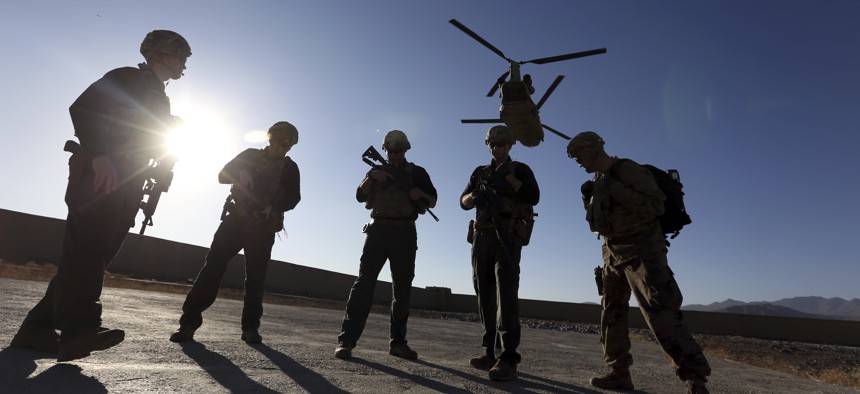
In this Nov. 30, 2017 file photo, American soldiers wait on the tarmac in Logar province, Afghanistan. The U.S. is pausing movement of troops into Afghanistan and quarantining 1,500 new arrivals to country due to virus. AP Photo/Rahmat Gul, File
Trump: US To Withdraw 4K Troops From Afghanistan By Election
“It’s already planned,” the president said in an interview with Axios.
The United States will draw down U.S. troops in Afghanistan by roughly half before the November presidential election, President Donald Trump said in an interview with Axios.
“It’s already planned. We’ll be down now in a very short period of time to 8,000; then we’re going to be down to 4,000,” Trump told Axios’ Jonathan Swan in an July 28 interview. Asked specifically how many troops would remain in Afghanistan by the time of the election on Nov. 3, the president said, “Probably anywhere from 4,000 to 5,000.”
Bringing troops down to 4,000 would put U.S. troop levels in Afghanistan at their lowest point since the early days of the 19-year-old war. Over the past six months, the United States has reduced the number of its troops in Afghanistan to about 8,600, in accordance with a deal brokered with the Taliban and signed in February. That deal envisioned the immediate drawdown from 14,000 to 8,600 troops by the summer, and a complete U.S. withdrawal within 14 months. Pentagon leaders have insisted that the second phase will be “conditions-based.”
But Trump has made it clear that he wants the United States out of Afghanistan, rarely speaking publicly about what “conditions” would be necessary to carry out that withdrawal and instead emphasizing the length of the conflict and complaining that U.S. soldiers are acting as “police” in the war torn country. Former and current administration officials have described him as eager to pull out by November in order to fulfill a key campaign promise from the 2016 election.
“We’ve been there for 19 years — 19 years,” the president told Axios.
The Defense Department declined to comment on the status of the planning for the next stage of the withdrawal — or its timing relative to the election — which has been reported by CNN, the LA Times and others.
“The agreement calls for additional conditions-based troop withdrawals as the peace process evolves,” a Defense Department spokesman said when asked about planning to reduce U.S. troops to 4,000 by the election. “The President’s direction on the issue has been clear, and the Department is moving to effectively implement that guidance in consultation with Congress and in close coordination with our NATO and partner nations.”
Taliban violence against the U.S.-backed Afghan government has risen sharply in recent months. Afghanistan President Ashraf Ghani in May ordered Afghan forces to resume “offensive” actions against the Taliban, dealing what some analysts say is a fatal blow to the fragile U.S.-brokered peace process — although not necessarily the U.S. withdrawal. Frustration with the lengthy conflict — which has killed 2,400 Americans and thousands more Afghan citizens — has grown into a national mood in recent years. Throughout the Democratic primary campaign, presidential candidates including presumptive nominee Joe Biden called for either an outright withdrawal or a substantial drawdown.
And defense officials have also long braced for the possibility that Trump, frustrated with the slow pace of the withdrawal process, may order a sudden and complete exit, as he did in Syria.
In the meantime, the deep cuts to 4,000 or 5,000 troops will almost certainly deeply degrade American counterterrorism capabilities in the country: Former officials say that 8,600 is probably the minimum number of troops needed to continue to carry out counterterrorism missions. Anything less than that, and the United States would start to lose valuable intelligence capabilities across the sprawling nation, they say.
Gen. Kenneth McKenzie, the top U.S. commander in the Middle East, said at a think tank event in June that he would not recommend a complete withdrawal from Afghanistan until the Taliban demonstrated that it no longer supported al Qaeda.
“If conditions would allow, we’re prepared to go to zero” by May 2021, McKenzie said. “If asked my opinion, those conditions have not been fully met.”
